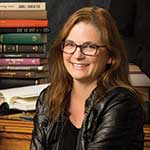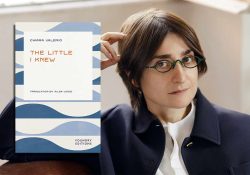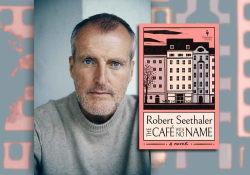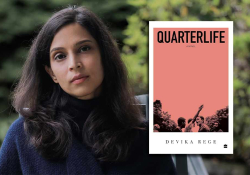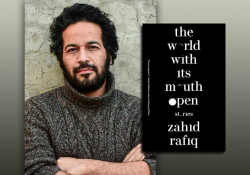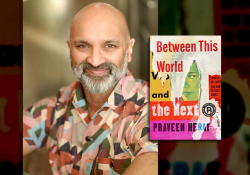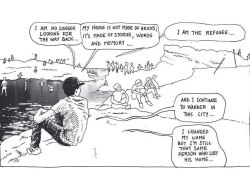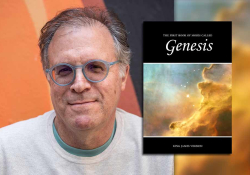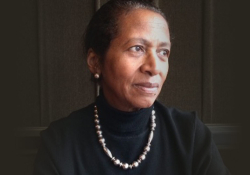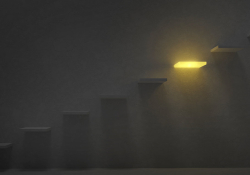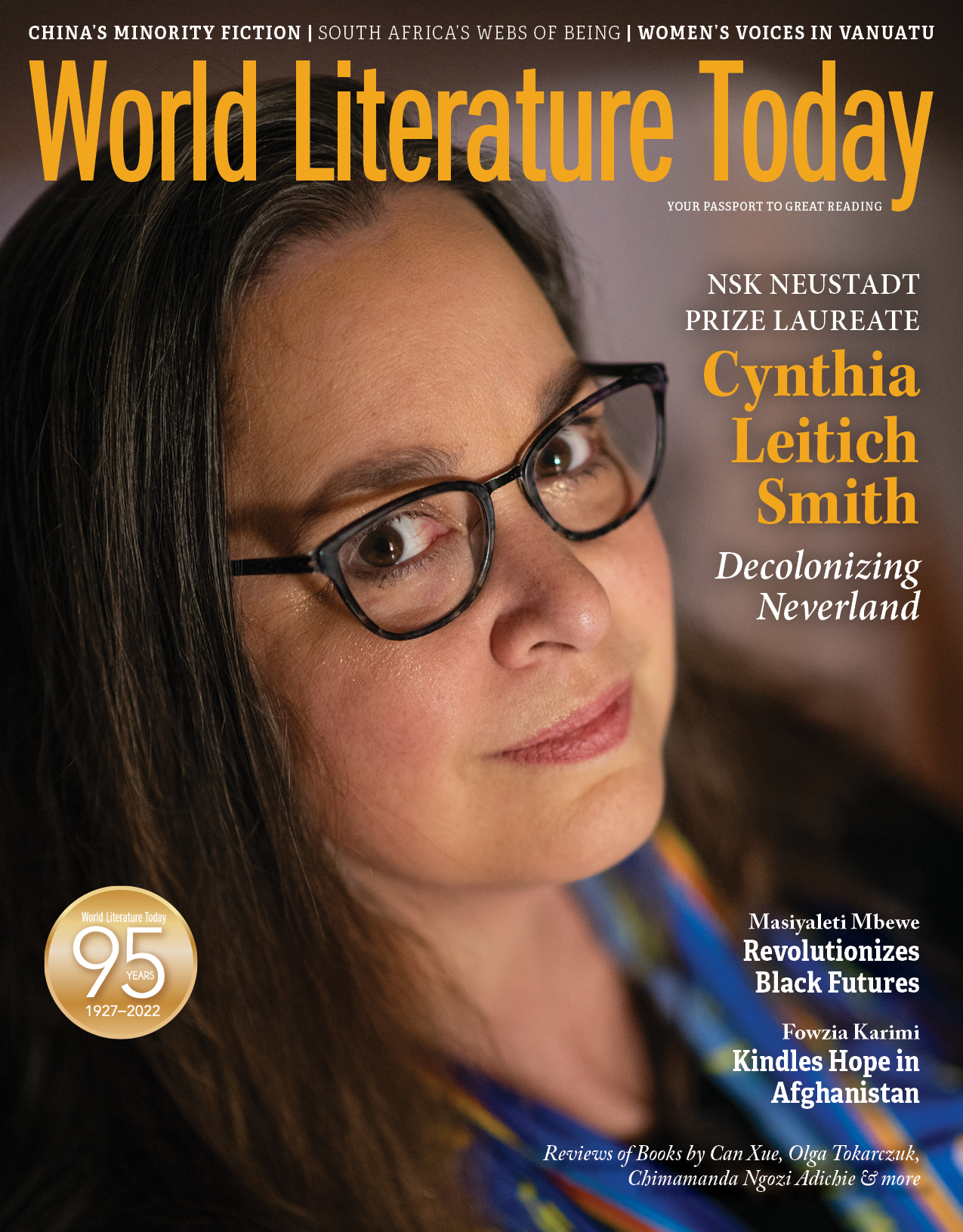“Imagining a Better Place”: A Conversation with Masiyaleti Mbewe about Revolutionizing and Constructing Black Futures
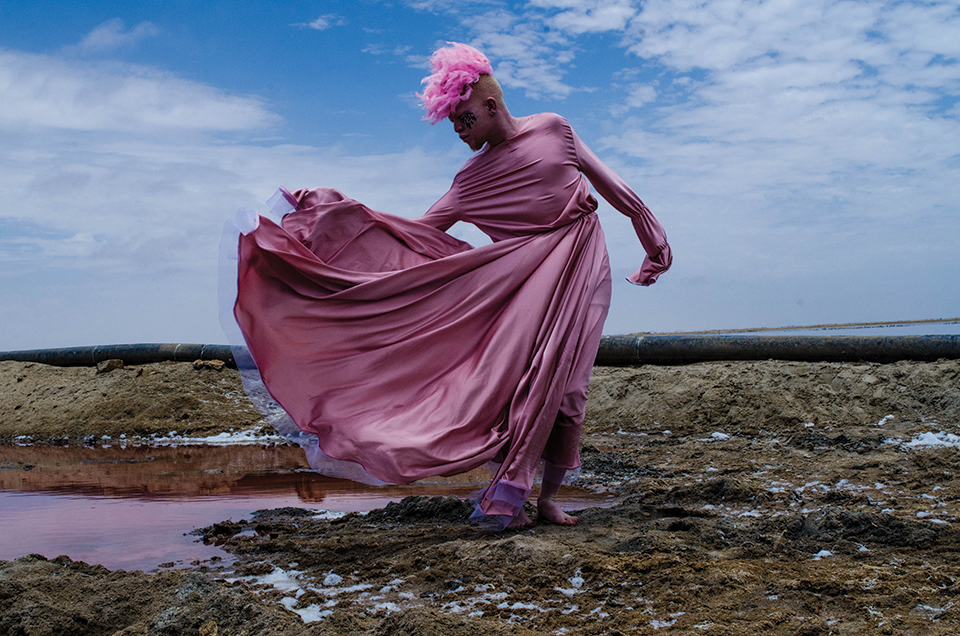
Masiyaleti Mbewe is a Zambian queerfuturist writer, photographer, and activist raised in Botswana and currently based in Namibia. Her photographic work in the Future African Vision in Time (FAVT) exhibition entitled The Afrofuturist Village navigates an alternative future for Africans in Afrofuturism. This first exhibit addressed environmentalism, feminism, mental health, technology, language, sexuality, gender, and accessibility and inclusivity. It included a hybrid language, braille, and sign language. Future exhibits—The Afrofuturist Town, The Afrofuturist City, and The Afrofuturist Metropolis—will continue this work.
Here she discusses her artistic work, her evolving understanding of Afrofuturism, and her reading, viewing, and listening recommendations.
Michelle Johnson: Should I ask you for your personal definition of Afrofuturism, or, instead, should we be speaking in terms of Pan-African futurism?
Masiyaleti Mbewe: My thoughts around Afrofuturism are constantly expanding, but I always return to Ytasha Womack’s definition. I think it very succinctly touches on the many intersections of Black diasporic futurist concerns. When I sat with Philipp Khabo Koepsell, I think we were trying to unpack or, rather, reconcile the myriad of complicated feelings we had with the term and its coining. I think we collectively settled on Pan-African futurism because of the underlying political implications; it encouraged a sort of solidarity with Black people around the world and further recognized the disparities with our lived experiences.
One might ask if the term Afrofuturism didn’t already do that, and I think our initial understanding of the term and its alignment with mostly the African American experience flattened the ways Africans on the continent and in the diaspora engaged with the concept. I think what Nnedi Okorafor did when coining Africanfuturism a year later also similarly identified these nuances, but I find that it is often difficult to discuss these things without sparking a diaspora war of sorts.
Johnson: How have your thoughts on Afrofuturism evolved from your 2015 Ted Talk to today? While doing research for this interview, I’ve become captivated by the way you continue to expand inclusion.
Mbewe: I was twenty-four when I stood on the TEDx stage, and I was excited to finally have the language to talk about how marginalized Black voices were in science fiction, fantasy, etc., and tracing how these different genres had their roots in traditional African mythology and spirituality was another incredibly validating thing to come out of the experience. I’m in my thirties now and am still very cognizant of that when I’m working. Because of the talk, I’m now in community with an amazing group of Black activists, scholars, and artists (Ingrid LaFleur, Alexander G. Weheliye, Nashilongweshipwe Mushaandja, Philipp Khabo Koepsell, and many more) who operate in these spaces that are constantly revolutionizing and constructing Black futures. But yes, the more I worked and grew, the more I wanted my work to be inclusive and intersectional. There was no way I was going to write about or make visual art about Black people and have my work replicate exclusionary politics.
Johnson: In an interview elsewhere, you mentioned your trajectory—pan-African futurism, then postfuturism, and now queer futurism, “which incorporates all of those things for me.” How does queer futurism do this?
Mbewe: Queerfuturism is a term I’m most comfortable with at the moment because it actively reflects who I continuously want to center in my work, Black queer folk. When I was talking about postfuturism, I think I was in the process of theorizing what Black futurism would look like outside of the capitalist excitement that came with Afrofuturism’s popularity. The future is pro-Black, queer, and anticapitalist, so I think the word queer obscures the way we approach things with rigidity sometimes. I like to think of my work here as some type of fluid, and queerness permits me that.
The future is pro-Black, queer, and anticapitalist.
Johnson: What alternative future for Africans did you envision in your 2018 exhibition, The Afrofuturist Village?
Mbewe: I definitely had a lot of themes in mind. I wanted to tackle environmentalism, feminism, mental health, technology, language, sexuality, gender, and accessibility and inclusivity. I really wanted to frustrate the stereotypical ideas people had around the visual impressions of Afrofuturism and link them back to African spirituality and the concept of Ubuntu; that’s why I worked with a traditional healer to cleanse the exhibition space. I’ve started to think about futurism in less linear ways because of how much the past really bleeds into everything. I liked how disruptive that challenging the perceptions around how space and Blackness connected could be. Ultimately, I was just imagining a better place . . .
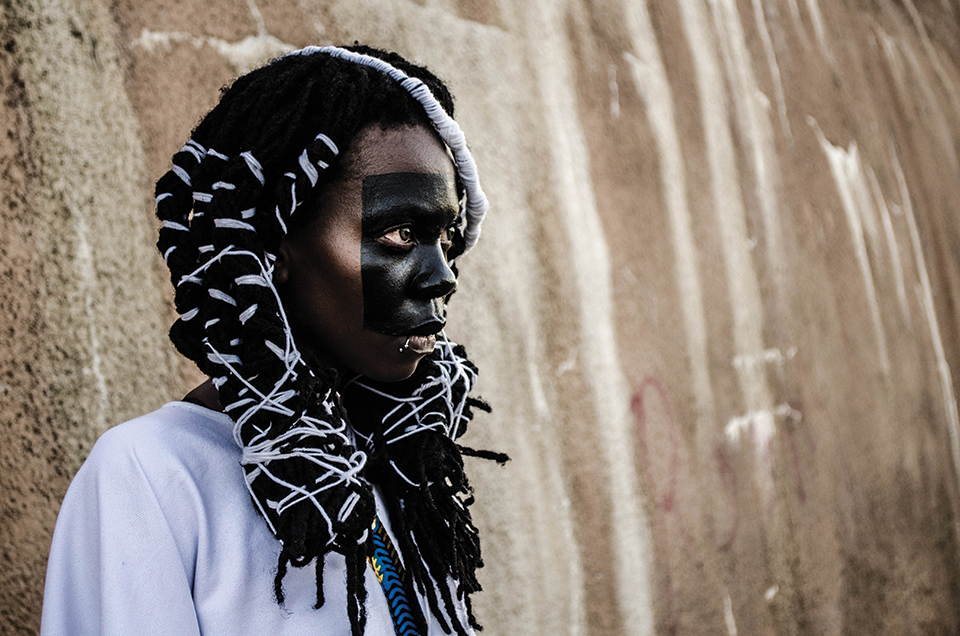
Ultimately, I was just imagining a better place.
Johnson: You used braille for the visually impaired and sign-language interpretations for the hearing impaired in The Afrofuturist Village. How do you anticipate expanding this in your future exhibitions, The Afrofuturist Town, The Afrofuturist City, and The Afrofuturist Metropolis? Are you already envisioning how you will make these more inclusive? Will the city and metropolis address ableism, for example?
Mbewe: The Afrofuturist Village was ambitious, so I know moving forward expanding this exhibition and its concept has to be a collaborative effort that affords different activists and artists the space to transform the village into a town, then into a metropolis, etc. There are so many things that I could have done better with the initial exhibition; as much as I collaborated with a team to bring the whole vision to life, I truly sit in the discomfort of how I could have better made the aspects of the exhibition that wanted to contend with ableism clearer and sharper. So, it is really about working with artists and disability activists to bring a collective vision for other installments of the exhibitions to life.
Johnson: In the interview “Moving Past Afrofuturism,” you talked about including an excerpt from American poet June Jordan’s theories on language asserting that “whoever ‘owns’ a language gets to decide how it’s used, how it shapes things, and how they can ‘weaponize’ it.” In response, you invented a language that your characters could use so that they were in full control of their futures. Could you tell us more about this language and, if you already know, how it might continue in your future exhibits?
Mbewe: I originally wanted to collaborate with a linguist to really work on constructing the language from scratch, but I didn’t have enough time, so between Setswana, Lozi, Nyanja (and some aspects of Khoekhoegowab thanks to multidisciplinary artist Nesindano Nunu Namises), a sort of hybrid language worked as a placeholder until a time when I could really explore the concept of a future language was created. As you said, it was about communicating an ownership of how different people that hold a multitude of identities alongside being Black could shape their futures through language. I would love to revisit that and do something cool with it, absolutely.
Johnson: How did you select the locations for the photos in your exhibit? Where is the exhibit “set”?
Mbewe: We shot the exhibition in different parts of Namibia, mainly Swakopmund and Windhoek. On a trip to the coast driving past the dunes, I made a mental note about how isolating and remote some parts of Namibia could feel, and I thought there were really eerie and quietly futuristic spaces that acted as pockets or portals to this village in my head. When I was shooting Diana Abankwah, we were in Town Square right in the heart of Windhoek, and the juxtaposition of a radical womanhood that she represented really interrupted the usual flow of the space, and in some outtakes, you can see how her perceived alienness threw people off by the looks on their faces. We also shot at the Moon Valley and at the beach in Swakopmund, Pink Lagoon in Walvis Bay, and even in a garage space. I think this really worked well with my idea of Black people owning space. There were obvious futurist aesthetics that I wanted to highlight, but cumulatively, they are in The Afrofuturist Village.
Johnson: This is an interesting shift for those who immediately associate Afrofuturism with intergalactic representations. Even the short film Afronauts, which is from Zambia and connects with events in Zambia in the 1960s, ties futurism with space.
Mbewe: I really liked the film, and when I read Namwali Serpell’s essays on the history of the Zambian Space Program and Edward Mukuka Nkoloso, I thought they were brilliant and highlighted some very important points, and I think Black people are within their rights to envision themselves anywhere. Reading the reimagined history in The Old Drift later was also crucial in shaping the way I think about the future and space lately. I think my exhibition was speaking to a very different interpretation of the idea of what space could look like or translate into. So, taking up space, demanding space, disrupting space, reclaiming space, owning space, etc.
Johnson: Your exhibit opened within days of the Black Panther premiere. In the US, this film is one of the most immediately identifiable works of Afrofuturism. How would you assess Black Panther as a work of Afrofuturism?
Mbewe: You could definitely read Black Panther from an Afrofuturist perspective. Like any piece of media, there are aspects of it that can be unpacked, critiqued, and celebrated. I think it was at the center of a lot of very important discourses, and I really enjoyed how it worked as an introduction to Afrofuturism for some people; there were so many things to take away from it from various standpoints, and it will continue to function as a pivotal reference point because of how much of a cultural impact it had.
Johnson: You said in your Ted Talk that Octavia E. Butler is, or was then, your favorite writer because of the novel Fledgling. What is your list of essential Afrofuturist texts and arts? If you were teaching an interdisciplinary course, what would always be on the syllabus?
Mbewe: One of the things I like about this question is how it puts me in a position I’ve always wanted to be in, as a teacher. This is what my syllabus would look like:
Books (fiction and nonfiction)
Lilith’s Brood and Parable series by Octavia E. Butler
Playing in the Dark, by Toni Morrison
PET, by Akwaeke Emezi
We Travel the Space Ways: Black Imagination, Fragments, and Diffractions (Post-colonial Media Studies), edited by Henriette Gunkel and Kara Lynch
Queer Times, Black Futures, by Kara Keeling
Speculative Blackness: The Future of Race in Science Fiction, by Andre M. Carrington
Bodyminds Reimagines: (Dis)ability, Race and Gender in Black Women’s Speculative Fiction, by Sami Schalk
Africanfuturism: An Anthology, published by Brittle Paper
The Old Drift, by Namwali Serpell
Afrofuturism, by Ytasha Womack
Films
Sankofa
Iitandu
Pumzi
Atlantics
His House
See You Yesterday
Stillborn
Daughters of the Dust
There are so many more, and of course we would analyze quite a lot of visual art.
Johnson: Who do you make art for?
Mbewe: Long story short, I make art for Black people.
Johnson: What art, music, film, and writing—futuristic or not—do you find yourself returning to for inspiration?
Mbewe: A lot of the literature and film I return to I listed above. I watch a lot of anime and engage with a lot of media from all over the world, but when it comes to inspiration, I work from a very nostalgic place. I almost hauntologically long for the future, but it’s feelings about the past that usually take me to that place.
Black people critiquing and talking about Black art and its implications and impact is a crucial part of how we collectively construct our futures.
Johnson: Last year, Beyoncé’s visual album Black Is King sparked a debate over Afrofuturism. Do you have a perspective to share about it?
Mbewe: I have nothing but good things to say about Beyoncé. I think the conversations that came from its release were nuanced, and there were some incredibly well thought-out takes (and a couple of not so good takes). I think Black people critiquing and talking about Black art and its implications and impact is a crucial part of how we collectively construct our futures. I encourage this sometimes radical and thoughtful analysis of the things we make.
Johnson: If we were to create a playlist to accompany this conversation (and I really think we should), what songs would you add to these two, assuming you would agree they are within Afrofuturism?
1. Lil Nas X, “Panini”
2. Janelle Monáe feat. Erykah Badu, “Q.U.E.E.N.”
Mbewe: I made a Spotify playlist (“Futuresythesis”) of the music I was listening to around the time of my exhibition. It was on a loop in the gallery at the Goethe-Institut Namibia that week and a half as well.
July 2021
